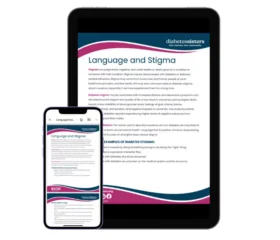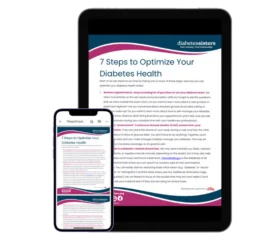Understanding Kidney Disease: Insights into Signs, Symptoms, and Diagnostic Tests

We are pleased to present the second article in a three-part series sponsored by The BI-Lilly Alliance and written by Amy Hess Fischl, MS, RD, LDN, BC-ADM, CDCES. Content is provided for information only; please consult with your healthcare provider before making changes to your diabetes management.
In our first article, we discussed prevention of kidney disease, along with risk factors and self-management. In this article, our focus will be on all things kidney disease: what it means, signs and symptoms as well as a more in-depth review of the screening and diagnosis tests we touched on previously.
What is kidney disease?
Your kidneys are important because they keep the rest of your body in balance. I like to think of them as one of my top 3 organs. So, what do they actually do for us? Our kidneys:
- Remove waste products from the body
- Balance the body’s fluids
- Help keep blood pressure under control
- Keep bones healthy
- Help make red blood cells
Kidney disease or chronic kidney disease (CKD) means that the kidneys have been damaged. Kidneys can get damaged from a physical injury or a chronic condition like diabetes or high blood pressure. Once your kidneys are damaged, they cannot filter your blood or do the other jobs as well as they should. Treatment in the early stages can help keep kidney disease from getting worse.
Screening tests — How do I know if I have kidney disease? (1)
Most people with early kidney disease do not have symptoms. The best way to find early kidney damage is to have a urine test, called urine albumin and creatinine ratio (UACR) AND a blood test called an estimated glomerular filtration rate (eGFR) once a year. The UACR test checks for very small amounts of protein in the urine called microalbuminuria. It helps show kidney damage at an early stage in people with diabetes, which then can help stop it from progressing. The eGFR is the best way to find out how well your kidneys are working. Your healthcare provider will begin by testing your blood for a waste product called creatinine. When the kidneys are damaged, they have trouble removing creatinine from the blood. Creatinine is stored in muscle tissue and blood. The blood test for creatinine will help your provider find out how well your kidneys are working. But this is only the first step. Next, the lab will take the result of this test and put it into a math formula that includes your age, gender and race. The number that results from this math formula is called your eGFR. It tells your provider how well your kidneys are working.
Who should be screened?
If you have type 1 diabetes, screening should be done yearly starting 5 years after diagnosis
If you have type 2 diabetes, screening should start yearly at diagnosis
One really important thing to remember — not everyone with kidney disease gets kidney failure. With the right treatment, you can prevent kidney disease from getting worse. But, it is important to have these tests done regularly to make sure that you can keep it that way.
How kidney disease is diagnosed? (1)
Using the UACR and eGFR is the best way to diagnose kidney disease.
That is defined as a UACR >or=30 mg/g
and/or
eGFR <60 mL/min/1.73m2
There are five stages of kidney disease and they coincide with your eGFR and UACR shown in the graphic below (2):

If you fall in any category other than low risk, your healthcare team should be providing treatment to reduce the risk of kidney disease progression.
Signs and symptoms of kidney disease
Early kidney disease rarely has symptoms. That is why it is so important to be tested regularly by your healthcare team. An early sign of kidney disease is protein in the urine.
The more kidney damage someone has can affect how medicines work – especially insulin and other diabetes meds that increase risk for hypoglycemia. The medicines may work a lot stronger, which can lead to a much higher risk of hypoglycemia and a need for much lower doses than what was previously used.
For those who may not have done these screenings, fear not. Start now! You can make sure it does not progress any further.
Living with type 2 diabetes or high blood pressure? You could have kidney disease without even knowing it. It takes 2 – you and a healthcare professional – to detect kidney disease and take steps to help reduce serious complications. Click here to read more and request the test.
References:
American Diabetes Association. Chronic Kidney Disease and Risk Management: Standards of Care in Diabetes—2023 Diabetes Care 2023;46(Suppl. 1):S191–S202. https://doi.org/10.2337/dc23-S011.
DeBoer IH, Khunti K, Sadusky T et al. Diabetes Management in Chronic Kidney Disease: A Consensus Report by the American Diabetes Association (ADA) and Kidney Disease: Improving Global Outcomes (KDIGO)
Diabetes Care 2022;45:3075–3090 | https://doi.org/10.2337/dci22-0027.
Written by






